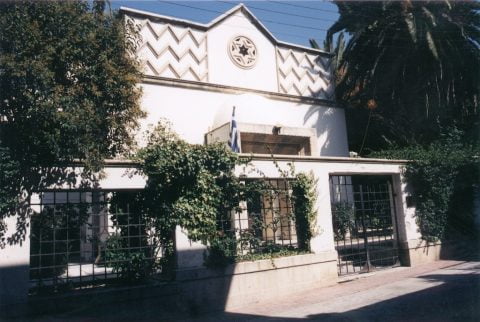A guided tour of the synagogue and Jewish heritage in Ingwiller.
Reservations necessary — and people must wear face masks.
There is also a tour at 14:00.
The cemetery has around 100 graves, with the oldest dating back to the 17th century.It was listed as a historic monument in 2016.



Exhibition: Let Them Make Me a Sanctuary! Synagogues of Hungarian Communities
The exhibition introduces the sacral architecture of the Hungarian Jewry by presenting individual synagogue buildings. The authors have selected works spanning nearly a millennium in order to present the characteristics of synagogue architecture, the communities that built them and their history. After the medieval synagogues of Sopron, the baroque synagogues of Mád and the neoclassical synagogues of Óbuda, the synagogues of Pest, the jewels of romantic architecture, will also be presented. These buildings, together with the domed synagogues built at the turn of the 19th and 20th centuries (Győr, Oradea, Szeged, Subotica, Novi Sad), were important milestones in the emancipation of the Jews. The sacral buildings of the Jewish community of Kassa (Kosice), which were built to complement the Slovakian stops in the exhibition, are also shown on separate tables, and are gems of Romantic and 20th century modern architecture.
Visit only on reservation: 32 2 209 0750 / info@bmki.be
The exhibition is a joint project of the Hungarian Academy of Arts and the Hungarian Museum of Architecture and Documentation Centre for Historic Monument Protection.
Curator: dr. Ágnes Ivett Oszkó, art historian, MÉM MDK
Project Manager: Ágnes Komlóssy, Head of the International and Transnational Affairs Department of the MMA

Inauguration of the restored synagogue on the island of Kos.
A new Ark and Bimah and other interior furnishings have been installed and — after decades out of its original use — the building will be rededicated as an active house of Jewish worship.
The Kos synagogue was built in the mid-1930s to replace an older synagogue that was destroyed in an earthquake in April 1933. It was abandoned after the near-total destruction of the circa 120 member Jewish community during the Holocaust, and then was purchased by the Municipality around 1984 and used as a local cultural centre.

Presenting a selection of nearly 150 pieces from various sources, this photographic exhibition recreates the history of Salonika (today Thessaloniki) Greece from the second half of the 19th century to the end of the First World War. Men and women are captured in their traditional costumes: modest artisans, porters, traders, members of the local “aristocracy;” society is revealed. Urban modernization is also shown: the quays and the White Tower, cafes, restaurants and entertainment venues; the Countryside sector where the notables established their residence; deprived areas, where emerging industries were established.
But also, in the now Greek city, the great fire of August 1917, an authentic trauma for the Jews who saw their historic neighborhoods, the municipal archives and more than thirty synagogues swept away by the flames, before the geopolitical upheavals caused by the First War worldwide.

An exhibition of art-enhanced photographs by Dmytro Polyukhovich based on the carvings on the centuries-old matzevot in the Jewish cemetery in Sataniv (which unfortunately has suffered extensive damage in recent years by a self-appointed Haredi man claiming to restore it).
The images for the exhibition focus on specific details of the carved iconography, which combines religious tradition with folk art — floral motifs, animals (and imaginary animals), symbols, religious allegories, and more.
To create the exhibition pieces, Polyukovich manipulated his original photos of the matzevot in Adobe Photoshop, cutting away everything except for the specific detail of the carving that he wanted to highlight and then adding color.
NOTE: The exhibition will be open every Wednesday and every Sunday from 10:00 a.m. to 7:00 p.m. It is also possible to organize group tours every Tuesday, Thursday and Sunday.

A multimedia exhibition by the artist, architect and historian Natalia Romik dedicated to the creativity of Polish Jews seeking to survive the Shoah in hiding.
In Poland and Ukraine during World War II, approximately 50,000 people survived persecution by the German occupying forces in hiding. The majority of them were Jewish. They found refuge in tree hollows, closets, basements, sewers, empty graves, and other precarious locations. Natalia Romik’s exhibition “Hideouts. The Architecture of Survival” pays tribute to these fragile places of refuge and explores their physicality. The show poses basic questions about the relationship between architecture, private life, and the public sphere: it addresses the protective function of spaces and emphasizes the creativity those in hiding brought to bear in their attempt to survive.
In a research project extending over several years, Natalia Romik and an interdisciplinary team of researchers consulted oral histories to identify several hiding places, which they explored using forensic methods. The multimedia exhibition “Hideouts. The Architecture of Survival” presents the results of this research. It consists of sculptures bearing a direct connection to the sites and includes documentary films, forensic recordings, photos, documents, and objects found in the hiding places.
“Hideouts: The Architecture of Survival” is presented in cooperation with the Zachęta National Gallery of Art in Warsaw and the TRAFO Center for Contemporary Art in Szczecin. On the occasion of the show at the Jewish Museum Frankfurt, a catalogue will be published in German and English editions by Hatje Cantz Verlag.
The exhibition was curated by Kuba Szreder and Stanisław Ruksza with the help of Aleksandra Janus (scientific collaboration). For the presentation in Frankfurt, Katja Janitschek, curator of the Judengasse Museum, was responsible for the curatorial project management. We would like to thank the Evonik Foundation for their generous support.


Comments are closed.